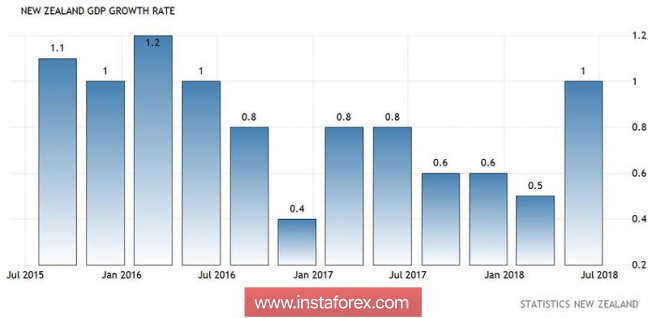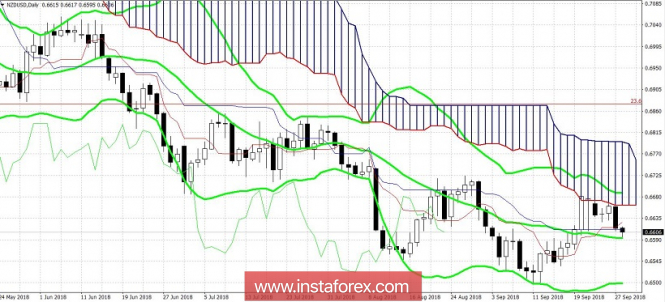The New Zealand dollar last week jumped all over the market after the release of the impressive given for New Zealand's GDP growth. Traders of the pair hoped that this fact will tighten the rhetoric of the Central Bank of the country, thereby indicating more "hawkish" prospects for monetary policy. But this did not happen. The regulator did not change its position, voicing only cautious optimism. The hopes of the bulls NZD / USD were destroyed, and the New Zealander again began to decline, all the more so amid the strengthening of the American currency.

It should be noted that the pair bulls did not foresee expectations for the September meeting of the RBNZ. According to published data, the economy of the country in quarterly terms jumped to 1% (from the previous 0.5%), and in the annual, to 2.8% (against 2, 6% in the first quarter). Positive dynamics was recorded in 15 of the 16 sectors of the economy, so the indicator was much better than forecast, and the pair NZD / USD jumped almost a hundred points in a day.
Let me remind you that at its previous meeting, the Reserve Bank of New Zealand disappointed with its extremely "pigeon" position. The regulator said that the issue of raising the interest rate would not be considered until 2020. Prior to this, the market was oriented towards the second half of next year, therefore the changed plans of the Central Bank were unpleasantly surprised. The New Zealander finally lost his foothold and collapsed to 2.5-year lows, that is, to the base of the 65th figure.

Then, pushing off from the level of support, "kiwi" demonstrated correctional growth, using the temporary support of the recovered indicator of business confidence in the country and subsequently, strong data on GDP growth. On the market, even talked about a larger growth, but for this, the bulls NZD / USD needed to break through the resistance level of 0.66665 (the lower boundary of the Kumo cloud on the daily chart), which was stormed four times over the past two weeks. That is why the September meeting of the RBNZ was so significant. If the regulator had returned optimism to the traders, the pair could easily pass this level of resistance and enter the 67th figure.
But the New Zealand regulator was unmoved. The current rate will not change upwards by at least until 2020, but it can be reduced if the economic situation demands. This position is attributed to RBNZ to several factors. This is the growth of the trade balance deficit, the extremely weak dynamics of the dairy products price index, the weak growth of the service sector, and the growth of trade barriers. This is not a complete list of negative factors, which was voiced at the September meeting. From positive moments, the regulator only noted: "early, preliminary signs of the growth of core inflation in the direction towards the middle of the target range." But this remark was the only one in favor of the New Zealand dollar. Therefore, the final impressions of the RBNZ meeting remained disappointing.
Of course, the southern dynamics of NZD / USD is due not only to the weakness of the New Zealand dollar, but also to the strengthening of the US currency. The Fed has made it clear that he is ready not only for the fourth round of rate hikes this year, but for the next three rises in the next year. The macroeconomic data published this week only confirmed the announced intentions.
Thus, the final estimate of US GDP growth was not revised downward (contrary to the warnings of some experts). The US economy grew by 4.2% in the second quarter, this is the highest growth rate in the last four years. Orders for durable goods also proved to be better than the forecast, although the growth of this indicator is explained by Boeing order. Without taking into account transportation, the index showed negative dynamics, has decreased to 0.1%. However, this nuance was ignored by the market, as well as a strong growth in the trade deficit in August, an increase in the number of applications for unemployment benefits and a decline in the housing market. Traders now prefer to see only the strengths of the US economy, not paying attention to the slowdown of some indicators.

All this suggests that the "kiwi" has the potential to further reduce it. The key support level in this context is the price of 0.6595, this is the average line of the Bollinger Bands indicator on the daily chart. If the pair consolidates under this target, then, firstly, the Ichimoku indicator will form a bearish Parade of Lines signal, and, secondly, the price itself will be between the middle and lower lines of the BB indicator on D1. In this case, the bears of the pair will have a wide price range for further reduction, up to the base of the 65th figure, that is, to the price minimums of this year. This scenario will be realized only with the "bilateral participation" of two currencies. If pessimism about the New Zealander intensifies, and the American dollar continues to gain momentum throughout the market.
The material has been provided by InstaForex Company - www.instaforex.com